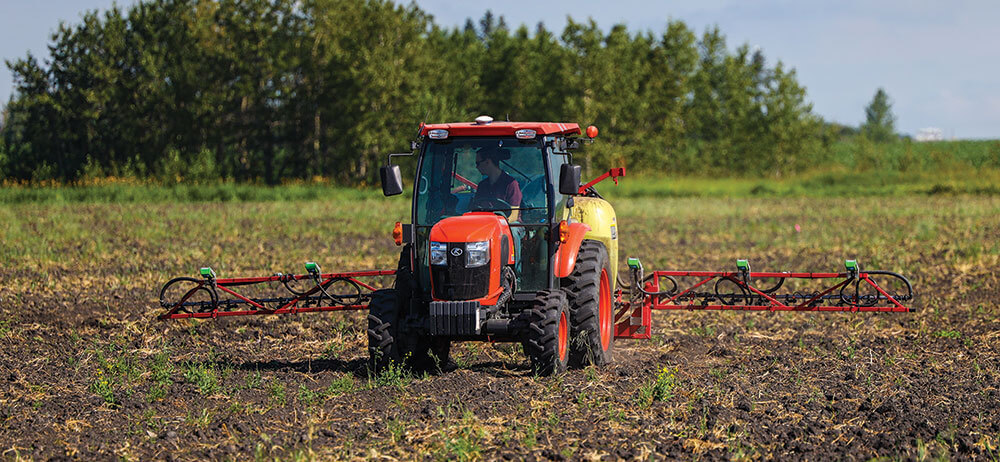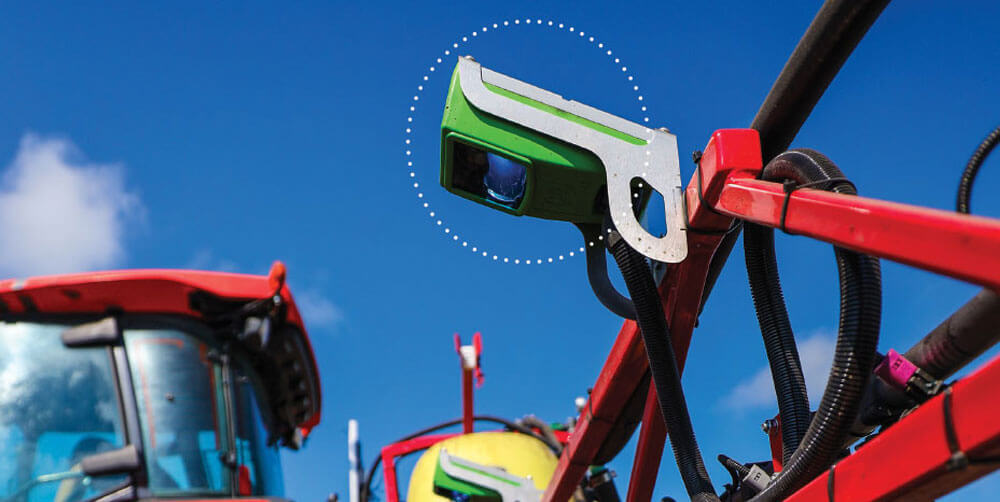Two years to pay off optical spot spray system
This case study describes how one farm uses optical spot spraying technology.
Name: Carl deConinck Smith
Location: Fiske, Saskatchewan
Soil zone: Brown
Crops: Canola, peas, lentils, wheat, barley, durum and flax
“With our system, we average a quarter litre of glyphosate over the whole field, but put up to 1.25 litres per acre on each weed. Our typical savings are 30 to 90 per cent, depending on how many weeds are present on the field.”
—Carl deConinck Smith
Carl deConinck Smith’s farm is 12,000 acres, of which 9,000 are seeded each year and 3,000 are rested as chemfallow.
Their spraying program each year includes in-crop spraying, pre-seed burnoff and fall weed control. For the applications on brown (non-crop) ground – pre-seed, fall and chemfallow – deConinck Smith uses the green-on-brown optical spot spraying technology currently on the market.
Their R4045 John Deere sprayer is the only sprayer in the world, deConinck Smith says, with the combination of direct injection and optical spot spray. With direct injection, he can inject glyphosate directly into the spray booms as needed and at variable rates, providing a tank mix addition to the product in the main tank. The direct injection system keeps glyphosate in its own 800-gallon tank separate from the main tank.
The optical spot spray system is from Weed-It. It comes with a 120-foot boom, and cost deConinck Smith around $290,000.
Tom Wolf described Weed-It in a detailed Canola Digest article from 2019. For a quick summary of Wolf’s article, Weed-It spray booms have sensors at one metre intervals. These scan the ground ahead of the boom, identify the presence of plants, and trigger the nozzle in line with the plant. A travel speed of up to 15 mph is possible.
John Deere also offers See & Spray optical spraying technology. “If you’re buying a new sprayer, this add-on is a no brainer,” deConinck Smith says.
His sprayer set-up gives him various options. He can apply full coverage across the field – the current standard practice. He can spot spray. Or he can opt for dual mode, which applies a low background rate across the field to capture small weeds that Weed-It can’t see and a higher spot-spray rate to larger weeds it can see.
“You need to understand what these systems are good at and not good at when you buy them,” deConinck Smith says. “Weed-It is good at seeing weeds with a broad leaf and in patches, but not good at seeing a newly-emerged wild oat. If you see lots of wild oats coming up, maybe that’s when you opt for the dual rate.”
“With our system, we average a quarter litre of glyphosate over the whole field, but put up to 1.25 litres per acre on each weed,” deConinck Smith says. “Our typical savings are 30 to 90 per cent, depending on how many weeds are present on the field.”
He adds that these gains are only possible if the farm already has a sound weed management program. If fields are full of weeds, spot spraying will not be worth it.
What deConinck Smith likes about spot spraying is that it provides “real time” variable rate application. “We don’t need to map weeds ahead of time.”

This leads to greater profitability. “With the investments we’ve made, it’s a two-year payback,” he says. By his calculations, an 8,000-acre farm can pay off the technology in two years. As glyphosate costs increase, the return on investment can occur that much faster.
“We’ve had zero reliability issues in five years with the system,” deConinck Smith says. Chemfallow is a good litmus test. “Chemfallow doesn’t lie. You can’t fake chemfallow.”
CCC analysis of the practice
What do you like about optical spot spraying? What details about deConinck Smith’s set up should farmers consider when calculating profitability?
Shawn Senko, Canola Council of Canada agronomy specialist: Optical spot spraying in dual mode allows farmers to hit larger weeds with a higher rate when they may not be able to justify the high rate across an entire field.
This reduces costs and, with a kill rate on the large weeds, prevents them from surviving and setting seed. Carl deConinck Smith has 3,000 acres of chemfallow each year, which is a major green-on-brown opportunity to help make the system pay. In working out the profit potential of this system, farmers will have to calculate their own opportunities to use it. As deConinck Smith says, fields also have to be fairly clean before spot spraying becomes effective.
How does the average farmer access this technology?
Shawn Senko: It may be a challenge to find a custom sprayer operator with this technology. Plus, if they’ve invested in the technology, will they be able to pass savings on to the farmer? In most situations, farmers will have to buy the technology themselves if they want to use optical spot spraying.
What is the sustainability message?
Shawn Senko: It should mean farms can achieve their weed management goals with lower overall rates of herbicide.
Weed-It at Olds College
Olds College of Agriculture & Technology wrapped up a two-year study of Weed-It. Project lead Shabeg Briar presented the results at Alberta Agronomy Update in January.
The two-year study used Weed-It for pre-seed burnoff in three spray modes: full spray, spot spray and dual mode. Dual mode included a blanket spray at a lower rate plus a spot spray application when optical sensors detected weeds. The study compared these three modes to a check that did not receive a pre-seed application. Strips were spread over two fields each year.
Year one was canola, year two was barley. Ahead of canola, researchers sprayed a mix of glyphosate (group 9) and Conquer II (group 14 pyraflufen-ethyl and group 6 bromoxynil). Ahead of barley they sprayed glyphosate and Paradigm (group 2 flurasulam and group 4 haluxifen). All treatment plots, including the untreated plots, also received two in-season, full rate, blanket spray applications. Researchers collected data on weed counts, application rate and harvest yield.
Weed counts were generally lower for treated versus untreated, and for full and dual treatments versus spot-sprayed plots. However, the spot-sprayed plots used 82 and 97 per cent less herbicide in the two canola fields and 88 and 98 per cent less in the two barley fields.
As for yield, this study showed no negative impact on yield with or without pre-seed herbicide application. “The need for pre-seed spray application depends on many factors, including prevailing weather conditions at the time of pre-seed spray application, weed pressure, weed size and weed management practices on a farm-by-farm basis,” Briar says. “Since conditions vary from year to year, farmers may need to keep this in mind before deciding to purchase optical spot spraying technology.”
Olds College plans to continue the research. Briar hopes to compare pre-seed spot spraying without any in-season spray application to in-season full spray without a pre-seed spot spray application. The study could also include comparisons to non-chemical weed control technologies, like chaff lining or mulching crop residue, and additional fall weed management. Another study could evaluated spot spray for chemfallow.






